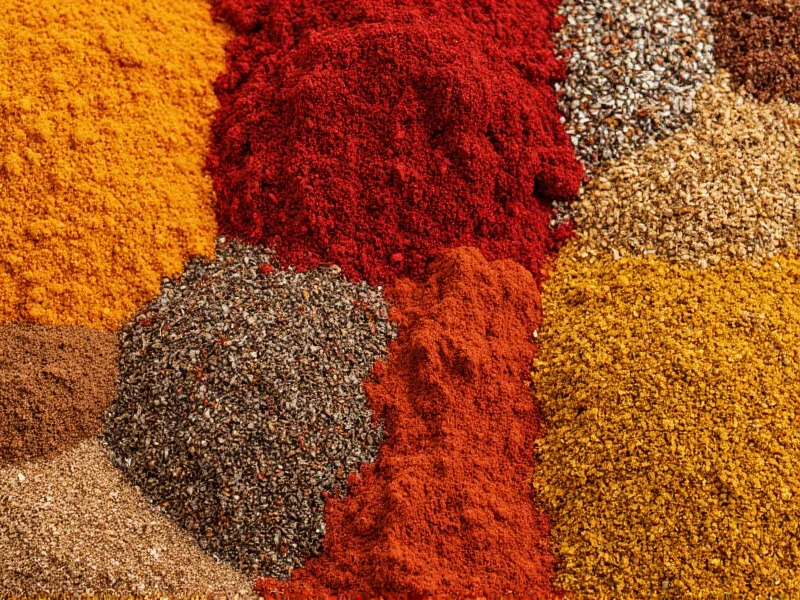Ethiopian spices create one of the world's most distinctive culinary traditions, characterized by complex heat, earthy depth, and aromatic complexity. Unlike many global spice traditions, Ethiopian cuisine relies primarily on two foundational blends—berbere and mitmita—rather than individual spices. These blends transform simple ingredients into extraordinary dishes through carefully balanced combinations of chili peppers, warming spices, and unique regional ingredients.
The Essential Ethiopian Spice Blends
While individual spices play important roles, Ethiopian cooking centers around signature blends that define the country's culinary identity. These blends vary by region, family tradition, and occasion, with some households maintaining recipes passed down through generations.
| Spice | Primary Ingredients | Heat Level | Traditional Uses |
|---|---|---|---|
| Berbere | Chilies, garlic, ginger, fenugreek, korarima, rue, ajwain | Moderate to high | Wat stews, doro wat, meat dishes |
| Mitmita | Bird's eye chilies, cardamom, cloves, cinnamon, salt | Very high | Kitfo, tibs, raw meat dishes |
| Nigella Seeds | Black cumin seeds | Mild | Injera bread, spice blends, vegetable dishes |
Berbere: The Heart of Ethiopian Cooking
Berbere represents Ethiopia's most iconic spice blend, featuring prominently in traditional wat stews that form the centerpiece of Ethiopian meals. This complex mixture typically contains 10-16 ingredients, with regional variations reflecting local preferences and available ingredients. Traditional berbere preparation involves toasting whole spices before grinding, a process that releases essential oils and creates deeper flavor complexity.
The base of authentic berbere always includes dried red chilies, with varieties ranging from mild to extremely hot depending on the region. Fenugreek provides earthy sweetness, while ginger and garlic contribute pungent warmth. Unique to Ethiopian spice traditions, korarima (Ethiopian cardamom) and rue add distinctive floral notes absent in other global spice blends.
Mitmita: The Fiery Counterpart
Where berbere offers complex warmth, mitmita delivers intense heat with aromatic sophistication. This vibrant orange powder combines bird's eye chilies with warming spices like cardamom, cloves, and cinnamon. Unlike berbere, mitmita contains no paprika or tomato elements, resulting in a cleaner, sharper heat profile.
Culinary experts note that authentic mitmita always includes Ethiopian cardamom (korarima), which differs significantly from Indian or Middle Eastern varieties. The distinctive citrus-floral notes of korarima balance mitmita's intense heat, making it suitable for seasoning raw meat dishes like kitfo—a traditional preparation of minced beef mixed with spices and clarified butter.
Unique Ethiopian Spice Ingredients
Beyond the signature blends, several individual spices define Ethiopian cuisine's distinctive character:
Korarima (Ethiopian Cardamom)
Often called "false cardamom," korarima belongs to the same botanical family as true cardamom but offers different flavor characteristics. With pronounced citrus and floral notes, it features prominently in both berbere and mitmita. Many Ethiopian households maintain their own korarima plants, harvesting the pods when mature for optimal flavor.
Nigella Seeds (Tikur Azmud)
These small black seeds, known locally as tikur azmud, provide earthy, onion-like flavor with subtle bitterness. Ethiopians use them extensively in spice blends, breads, and vegetable dishes. Unlike Indian cuisine where nigella appears in tempering, Ethiopian cooking often incorporates these seeds directly into doughs and stews.
Besobela (Ethiopian Basil)
This regional basil variety features prominently in religious fasting periods when Ethiopian Orthodox Christians abstain from animal products. Its distinctive anise-like flavor enhances vegetable dishes during these periods, offering aromatic complexity without violating dietary restrictions.
Cultural Significance of Ethiopian Spices
Spice preparation represents more than culinary technique in Ethiopia—it embodies cultural identity and community. Traditional spice making often involves multiple family members, with knowledge passed from elders to younger generations. The coffee ceremony, Ethiopia's most famous cultural ritual, frequently incorporates spices like cinnamon and cardamom, connecting daily life with aromatic traditions.
During major holidays like Timket (Epiphany) and Meskel (Finding of the True Cross), families prepare special spice blends for celebratory dishes. These occasions reinforce the connection between spice traditions and cultural identity, with regional variations reflecting Ethiopia's diverse ethnic groups.
Using Ethiopian Spices in Modern Cooking
Home cooks worldwide increasingly incorporate Ethiopian spices into diverse cuisines. When working with authentic berbere or mitmita, consider these practical tips:
- Start with small quantities—these blends pack intense flavor
- Bloom spices in oil before adding liquids to maximize flavor release
- Pair berbere with tomatoes and onions for traditional stew bases
- Use mitmita sparingly as a finishing spice for meats or roasted vegetables
- Store blends in airtight containers away from light to preserve potency
For those exploring traditional Ethiopian recipes, understanding spice balance proves essential. Authentic doro wat (chicken stew) requires berbere at just the right concentration—not so much that it overwhelms, but sufficient to create the characteristic deep red color and complex warmth that defines the dish.
Sourcing Authentic Ethiopian Spices
Finding genuine Ethiopian spices requires attention to detail. Local Ethiopian markets typically offer the freshest blends, with vendors often preparing batches weekly. When purchasing online, look for retailers specializing in Ethiopian ingredients who source directly from producers. Properly stored, homemade berbere maintains optimal flavor for 3-4 months, while commercial blends typically remain potent for 6-8 months.
Conclusion
Ethiopian spices represent one of the world's most sophisticated and distinctive culinary traditions. Through careful balance of heat, earthiness, and aromatic complexity, berbere and mitmita transform simple ingredients into extraordinary dishes. Understanding these spice traditions provides not just culinary insight but a window into Ethiopia's rich cultural heritage, where spice preparation remains deeply connected to community, celebration, and daily life. As global interest in authentic Ethiopian cuisine grows, preserving these traditional spice knowledge systems becomes increasingly important for maintaining culinary diversity worldwide.











 浙公网安备
33010002000092号
浙公网安备
33010002000092号 浙B2-20120091-4
浙B2-20120091-4